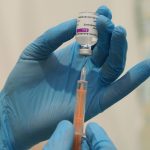England’s R number could be as high as 1, according to government scientists who have not given a UK figure for the first time.
The Scientific Advisory Group for Emergencies (SAGE) estimated England’s latest R number to be between 0.8 and 1 – up from between 0.7 and 0.9 across the whole of the UK last week.
This means that every 10 people who test positive for COVID-19 in England will pass it on to an average of eight to 10 others.
This week, scientists have not published a UK-wide estimate as they usually do, claiming that “given the increasingly localised approach to managing the epidemic”, those figures are “less meaningful than previously and may not accurately reflect the current picture”.
R – or the reproduction number – represents the average number of people someone with coronavirus will go on to infect. If the figure is above 1 the epidemic will grow exponentially, but if it is below 1 it is getting smaller.
The growth rate of the virus in England is now estimated to be -4% to 0%, which means that the number of new COVID infections is “broadly flat” or shrinking by up to 4% every day.
It comes after lockdown restrictions eased nationwide on Monday allowing up to six people or two households to meet in private gardens.
Police forces up and down the country have warned people not to flout the rules this Bank Holiday weekend, as they fear the long weekend and warm weather could encourage people to meet indoors or in large groups.






















